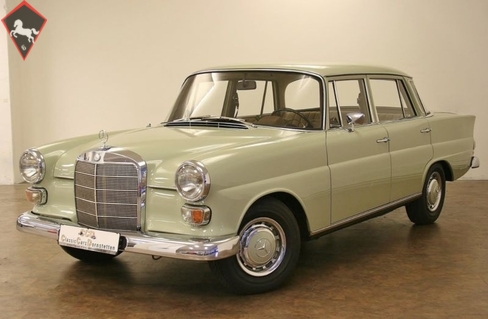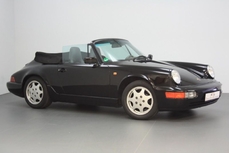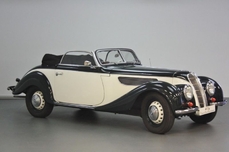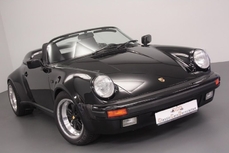Mercedes-Benz 200 w110 Fintail Heckflosse, Originalzustand, deutsch 1967
General description :
Diese Mercedes-Benz Heckflosse ist eine der Besten am Markt:
Als Neuwagen am 19. Oktober 1967 in Villingen an einen Textilkaufmann ausgeliefert, wurde der Mercedes nach dessen Tod 1979 auf die Ehefrau umgemeldet. 1987 übernahm der Mercedes-Händler, der den Wagen in den vergangenen 20 Jahren im Service hatte, das Fahrzeug für sich selbst. 22 Jahre später gelang es einem Kunden, ihm den Wagen abzuschwatzen. Um die Studienkosten seines Sohnes zu finanzieren, verkaufte er den Mercedes 200 drei Jahre später an den Centerleiter einer großen Mercedes-Benz Vertretung.
Danach hatte er noch einen weiteren Mercedes-Kenner als Besitzer, der ihn regelmäßig gefahren und sorgfältig gepflegt hat.
Das eindrucksvolle Scheckheft führt durch 50 Jahre Servicehistorie und wurde nur von Mercedes-Benz Vertragswerkstätten abgestempelt. Der Mercedes hat eine vollkommen originale Ausstattung, lediglich das historische Becker Radio (ein von Autoradio-Königs restauriertes Gerät) wurde nachgerüstet. Im wesentlichen ist der Wagen noch im Erstlack, partiell ist sehr kunstvoll nachlackiert, was man mit bloßem Auge nicht sieht. Alle gemessenen Schichtdicken liegen zwischen 130 und 330 tausendstel Millimeter, also sehr gute Werte. Das originale Bordwerkzeug und der Wagenheber sind vorhanden. Am Reserverad ist sogar noch der originale Anhänger mit den Hinweisen zum Radwechsel befestigt. Die Bordmappe ist vollständig bis hin zur Pflegeanleitung für die Radioantenne. Aschenbecher und Zigarettenanzünder sind unbenutzt. Der Wagen war immer garagiert, so dass die Sonne nichts ausbleichen konnte. Auch der Dachhimmel ist fleckenfrei. Die Bodenbeläge sind original und in tadellosen Zustand.
Überhaupt vermittelt das ganze Auto pure Authentizität: Hier einzusteigen, und die Türe zuzumachen, heißt in das Jahr 1967 einzusteigen und mit dem schließen der Türe das Jahr 2016 draußen zu lassen. Allein die Heizungsregulierung trägt mehr Chrom als heute eine ganze S-Klasse. Sie hören deutlich die Zeituhr ticken und wenn man das Radio einschaltet, ist man fast verblüfft, dass moderne Nachrichten kommen. Die üppige Polsterung und der gesamte Innenraum verbreiten historisches Mercedes-Flair. Man spürt die Zuneigung, die seine Besitzer für ihn empfunden haben. Und genau diese Ausstrahlung, diese Anmutung kann kein Restaurator dieser Welt wieder hochholen. So etwas kann nur in Jahrzehnten penibelster Pflege und Fürsorge wachsen.
Automatik, Servolenkung und rechter Außenspiegel waren damals teure und seltene Ausstattungen auf die man so stolz war, dass das Wort "Automatik" als verchromter Schriftzug auf dem Kofferdeckel prangt. Der Chrom ist buchstäblich blendend und die Stoßstangen wirken so massiv, als ob man damit einen ICE anschieben könnte. Die Lackierung in Graubeige, einer ganz typischen Farbe der sechziger Jahre, wirkt angenehm unaufdringlich. Er ist seit 50 jahren unfallfrei. Möglicherweise überträgt sich ja die hastlose Würde und Gelassenheit des Mercedes auf den Fahrstil seines Eigners.
http://home.mobile.de/CLASSICCARSDORNSTETTEN#des_247492052
1967 Mercedes-Benz 200 w110 Fintail Heckflosse, Originalzustand, deutsch is listed sold on ClassicDigest in Freudenstädter Str. 28-32DE-72280 Dornstetten by Auto Dealer for €29900.
Car Facts
Car type : Car Make : Mercedes-Benz Model : 200 w110 Fintail Model Version : Heckflosse, Originalzustand, deutsch Engine size : 2.0 Model Year : 1967 Sub type : Sedan Location : Freudenstädter Str. 28-32DE-72280 Dornstetten
Sold
Seller Information
Sold
Other cars listed for sale by this dealer
About Mercedes-Benz
In the annals of automotive history, the journey of Mercedes-Benz is a tale that unfolds with the ingenuity of its founding pioneers. In the year 1886, Karl Benz crafted the Benz Patent Motorwagen, a creation that would go down in history as the world's inaugural automobile. Unbeknownst to him, this moment marked the genesis of what would evolve into the most illustrious premium car manufacturer globally. The financial underpinning of this pioneering venture, interestingly, was provided by Karl Benz's wife, Bertha Benz, demonstrating a remarkable partnership that would set the tone for Mercedes-Benz's legacy.A parallel narrative emerged not far away, as Daimler-Motoren-Gesellschaft, founded by Gottlieb Daimler and Wilhelm Maybach, entered the scene. In 1901, they unveiled their automobile under the now-famous moniker "Mercedes," meaning "godsend" in Spanish. This name was bestowed upon the car at the behest of Emil Jellinek's daughter, the distributor for Daimler-Motoren-Gesellschaft. The wheels of innovation were set in motion.
Fast forward to 1926, a pivotal year that witnessed the merger of Daimler with Benz & Cie., culminating in the birth of Daimler-Benz. The amalgamation saw the adoption of "Mercedes-Benz" as the distinguished trademark for their automobiles, fusing the legacies of two visionary entities into one.
Contrary to perceptions of conservatism, the trajectory of Daimler-Benz unfolds as a chronicle of industry firsts. From the introduction of the honeycomb radiator to the float carburetor, and the pioneering implementation of four-wheel brakes in 1924, Daimler-Benz consistently pushed the boundaries of automotive innovation. The diesel-powered Mercedes-Benz 260 D in 1936 marked the inception of diesel engines in passenger cars. The iconic Mercedes-Benz 300SL Gullwing made history as the first car with direct fuel injection, albeit the Gutbrod's tiny 2-stroke engine can claim precedence.
Safety innovations became a hallmark, with Béla Barényi's patented safety cell design in the "Ponton"-models in 1951, featuring front and rear crumple zones. The W116 450SEL 6.9 saw the introduction of the Anti-Lock Brake system (ABS), another pioneering safety feature. From the first production airbags and beyond, the legacy of "firsts" continued to be etched into the fabric of Daimler-Benz.
Over its centennial journey, Mercedes-Benz has not merely produced cars but has sculpted automotive icons. The SSKL, 710 SSK Trossi Roadster, 770K Grosser, 540K Spezial Roadster, 300SL Gullwing, w100 600 Pullman, w111 280SE 3.5 Flachkühler, w113 230SL Pagoda, w109 300 SEL 6.3, and w201 2.3-16 Cosworth stand testament to the brand's commitment to engineering excellence.
The roaring Silver Arrows, or "Silberpfeile," including the W 25, W 125, W154, W165, and W196, created a legacy of dominance on the racetrack. These machines were not merely cars; they were expressions of precision, speed, and an indomitable spirit that left their competitors in the dust.
As Mercedes-Benz marches into the future, it does so not just as an automaker but as a custodian of a legacy, a torchbearer of innovation, and a beacon of automotive excellence. The road ahead is sure to witness the continued fusion of cutting-edge technology, timeless design, and an unwavering commitment to setting new standards in the world of automobiles.
One luminary figure who left an indelible mark was Béla Barényi, often heralded as the "father of passive safety" for his pioneering work in safety engineering. His patented safety cell design, featuring front and rear crumple zones, became a hallmark of Mercedes-Benz's commitment to occupant safety, setting new standards that reverberated throughout the automotive world.
Moving through the chronicles, the collaborative genius of Wilhelm Maybach, alongside Gottlieb Daimler, laid the foundation for Daimler-Motoren-Gesellschaft. Their innovations not only birthed the first Mercedes but established a culture of relentless pursuit of technological excellence that remains integral to Mercedes-Benz's DNA.
In the post-merger era of 1926, Ferdinand Porsche emerged as a prominent figure within Mercedes-Benz. His work on the Mercedes-Benz S-Type, a supercharged race car, garnered acclaim and set the stage for a legacy that extended far beyond the marque. Porsche's impact would later extend to his eponymous company, but his influence at Mercedes-Benz during those formative years was pivotal.
As the 20th century progressed, the legendary Rudolf Uhlenhaut emerged as a key figure. Uhlenhaut, an accomplished engineer and the driving force behind the iconic Silver Arrows, played a crucial role in Mercedes-Benz's dominance in motorsports. His engineering prowess and attention to detail were instrumental in creating some of the most formidable racing cars of the era.
In the latter half of the century, figures like Bruno Sacco, the head of design at Mercedes-Benz from 1975 to 1999, left an indelible imprint on the brand's aesthetic identity. Sacco's design philosophy, characterized by clean lines and timeless elegance, shaped iconic models like the W126 S-Class and the W201 190E, solidifying Mercedes-Benz's reputation for luxury and sophistication.
The narrative would be incomplete without acknowledging the contributions of engineers like Hans Scherenberg, whose leadership in the 1970s ushered in a new era of technological innovation at Mercedes-Benz. Scherenberg's tenure saw the development of groundbreaking technologies, including the Anti-Lock Brake system (ABS) and the introduction of airbags in production cars.






